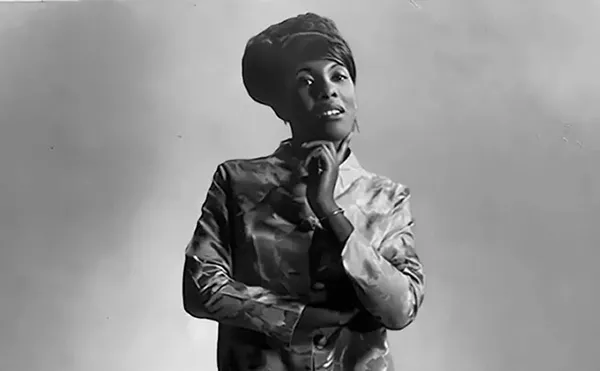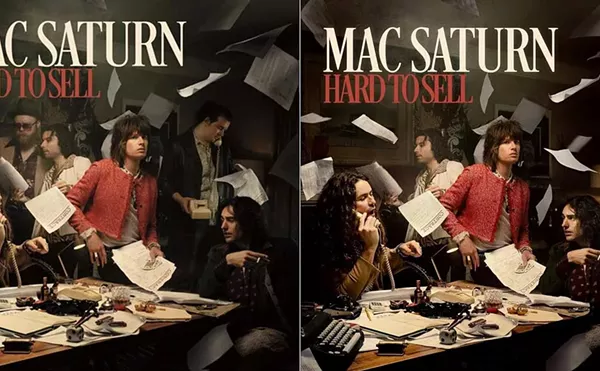
Audio By Carbonatix
[
{
"name": "GPT - Leaderboard - Inline - Content",
"component": "35519556",
"insertPoint": "5th",
"startingPoint": "3",
"requiredCountToDisplay": "3",
"maxInsertions": 100,
"adList": [
{
"adPreset": "LeaderboardInline"
}
]
}
]
Page 3 of 4
Sam Cooke was gospel's first sex symbol, and he was also, lets face it, a total dog. He slept around, had orgies, got many women pregnant, then ran back to his wife. He was by all accounts addicted to sex with prostitutes and died half naked in a cheap motel on the outskirts of Los Angeles while allegedly assaulting the woman who owned the place. But you know, except for the death part, I think I could just have described David Copperfield or the weird freckled kid from The Partridge Family. Far too much is made of the seedy side of Cooke's life.
And here I have to admit that my thesis grew more and more simplistic the more I dug into my subject matter, to the point that it vanished in front of my eyes. Surely the almost nine-minute live take of "Nearer My God to Thee," performed in Los Angeles on July 22, 1955, develops as a series of climaxes built atop one another, the whole group winding each other up, vocal whirling dervishes. But in spite of all of Cooke's sexy charisma, it's geared toward a different kind of ecstasy. Listening to it is like watching a group of gymnasts throw their lightest and strongest member straight towards the stage lights as he twists and turns, then disappears.
The Shrine Concert that this performance is from was overseen by Specialty label head Art Rupe after gospel singer Brother Joe May had suggested the idea to do a live recording. May had been blown away by a series of live 78s issued by Reverend Killens in the late 1940s. "People are shouting and carrying on," Brother May wrote in a letter to Rupe in the early '50s. "To tell you the truth, I could do this better if I would rehearse it." The Shrine Concert was the largest event of its kind on the West Coast. In Singing In My Soul: Black Gospel Music in a Secular Age, author Jerma Jackson compares the milestone event in size and scope to Sister Rosetta Tharpe's wedding concert in July 1951 — when 15,000 people descended onto Griffith Stadium in Washington, D.C., to celebrate the guitarist and singer's wedding ceremony followed by musical performances.
Held at the 6,500-person-capacity Shrine Auditorum in Los Angeles, the Shrine show was officially called the First Annual Mid Summer festival of Gospel Music, virtually ensuring it would be a one-off event. Rupe had both large and well-known acts on the bill: the Pilgrim Travelers, Brother Joe May, the Soul Stirrers, and Dorothy Love Coates with the Original Gospel Harmonettes, who had the unenviable task of following the Stirrers. Veteran L.A. disc jockey Brother Clarence Welch produced the event, while Seattle-based producer, musician, and con artist Robert Bumps Blackwell was enlisted to oversee the recording, as he'd spent years recording his own jazz band live.
What does it mean that this is the only time we ever really get to hear Cooke shout like this? How can it be that he's delivering his curlicued yodel as a shout at various points throughout this thing? And listen to the response every time he does — it's totally causing a mass falling-out throughout the entire auditorium. At times Cooke's trading off on lead with Paul Foster, as on the chorus, but this is Cooke's song and you know it. On one hand it feels like Cooke is betraying something essential about himself with this recording — it's the opposite of smooth; from another perspective this is the realest Cooke ever sounded on a recording. This wouldn't be heard for 20-odd years of course — not in Cooke's lifetime.
Where many commercial gospel recordings of the era — absolutely wonderful as they are — exist to quickly evoke "church" in two- to four-minute bites, winding up quickly towards that ecstatic release point, it's astonishing to hear what a gospel program with the greatest voices of the day — the ebb and flow and the buildups that lead to buildups — was really like. We're all aware that many sociologists insist the very function of African-American holiness and related traditions is to induce that ecstatic state, the trance, the "falling-out," that a parishioner has not even been to church if he or she has not left one's body, yelled aloud, spoke in tongues — depending on the denomination. The holiness movement was in many ways spurned by the ecstatic and extended Azusa Street Revival in Los Angeles at the turn of the last century, but these impulses are ancient.
The song itself, "Nearer," is remarkable. Guralnick considered it the best thing he'd written to date and that "for once you feel as if you might be peering into Sam's own soul" he writes.
Cooke's songwriting is as much about removing words and syllables as anything; they're little distilled poems that remind me a little bit of what I like about a second generation New York School poet like Joe Brainard or Anne Waldman. This might be a stretch, but thanks for following me there. Basically what you're left with seems so simple as to be kind of stupid at first but then you realize whatever it is, it's just been said perfectly, simply stripped of affect. In the case of a Sam Cooke pop song one's often left with cheesy schmaltziness, but it's so beguiling and transparent it rarely seems treacly; because of his delivery, you really believe that this person has sent him when he sings, "You Send Me," and every word is like a cloud of cotton candy freshly spun at the fairground just for you.
And here I have to admit that my thesis grew more and more simplistic the more I dug into my subject matter, to the point that it vanished in front of my eyes. Surely the almost nine-minute live take of "Nearer My God to Thee," performed in Los Angeles on July 22, 1955, develops as a series of climaxes built atop one another, the whole group winding each other up, vocal whirling dervishes. But in spite of all of Cooke's sexy charisma, it's geared toward a different kind of ecstasy. Listening to it is like watching a group of gymnasts throw their lightest and strongest member straight towards the stage lights as he twists and turns, then disappears.
The Shrine Concert that this performance is from was overseen by Specialty label head Art Rupe after gospel singer Brother Joe May had suggested the idea to do a live recording. May had been blown away by a series of live 78s issued by Reverend Killens in the late 1940s. "People are shouting and carrying on," Brother May wrote in a letter to Rupe in the early '50s. "To tell you the truth, I could do this better if I would rehearse it." The Shrine Concert was the largest event of its kind on the West Coast. In Singing In My Soul: Black Gospel Music in a Secular Age, author Jerma Jackson compares the milestone event in size and scope to Sister Rosetta Tharpe's wedding concert in July 1951 — when 15,000 people descended onto Griffith Stadium in Washington, D.C., to celebrate the guitarist and singer's wedding ceremony followed by musical performances.
Held at the 6,500-person-capacity Shrine Auditorum in Los Angeles, the Shrine show was officially called the First Annual Mid Summer festival of Gospel Music, virtually ensuring it would be a one-off event. Rupe had both large and well-known acts on the bill: the Pilgrim Travelers, Brother Joe May, the Soul Stirrers, and Dorothy Love Coates with the Original Gospel Harmonettes, who had the unenviable task of following the Stirrers. Veteran L.A. disc jockey Brother Clarence Welch produced the event, while Seattle-based producer, musician, and con artist Robert Bumps Blackwell was enlisted to oversee the recording, as he'd spent years recording his own jazz band live.
What does it mean that this is the only time we ever really get to hear Cooke shout like this? How can it be that he's delivering his curlicued yodel as a shout at various points throughout this thing? And listen to the response every time he does — it's totally causing a mass falling-out throughout the entire auditorium. At times Cooke's trading off on lead with Paul Foster, as on the chorus, but this is Cooke's song and you know it. On one hand it feels like Cooke is betraying something essential about himself with this recording — it's the opposite of smooth; from another perspective this is the realest Cooke ever sounded on a recording. This wouldn't be heard for 20-odd years of course — not in Cooke's lifetime.
Where many commercial gospel recordings of the era — absolutely wonderful as they are — exist to quickly evoke "church" in two- to four-minute bites, winding up quickly towards that ecstatic release point, it's astonishing to hear what a gospel program with the greatest voices of the day — the ebb and flow and the buildups that lead to buildups — was really like. We're all aware that many sociologists insist the very function of African-American holiness and related traditions is to induce that ecstatic state, the trance, the "falling-out," that a parishioner has not even been to church if he or she has not left one's body, yelled aloud, spoke in tongues — depending on the denomination. The holiness movement was in many ways spurned by the ecstatic and extended Azusa Street Revival in Los Angeles at the turn of the last century, but these impulses are ancient.
The song itself, "Nearer," is remarkable. Guralnick considered it the best thing he'd written to date and that "for once you feel as if you might be peering into Sam's own soul" he writes.
Cooke's songwriting is as much about removing words and syllables as anything; they're little distilled poems that remind me a little bit of what I like about a second generation New York School poet like Joe Brainard or Anne Waldman. This might be a stretch, but thanks for following me there. Basically what you're left with seems so simple as to be kind of stupid at first but then you realize whatever it is, it's just been said perfectly, simply stripped of affect. In the case of a Sam Cooke pop song one's often left with cheesy schmaltziness, but it's so beguiling and transparent it rarely seems treacly; because of his delivery, you really believe that this person has sent him when he sings, "You Send Me," and every word is like a cloud of cotton candy freshly spun at the fairground just for you.






